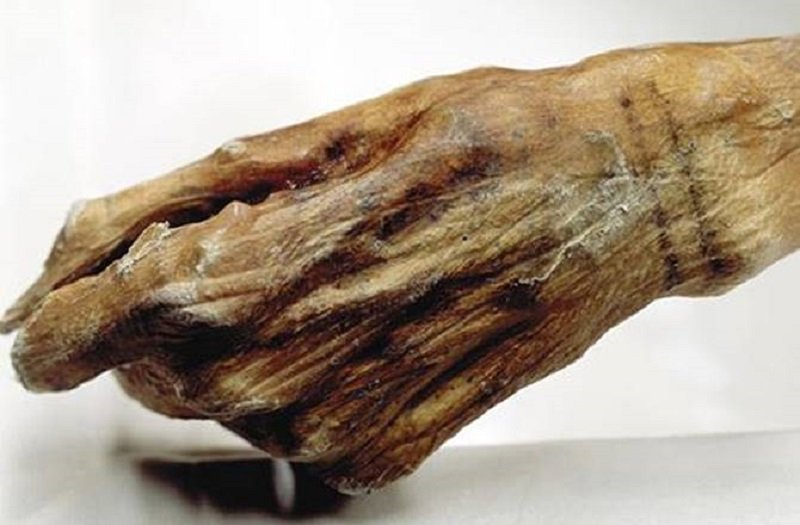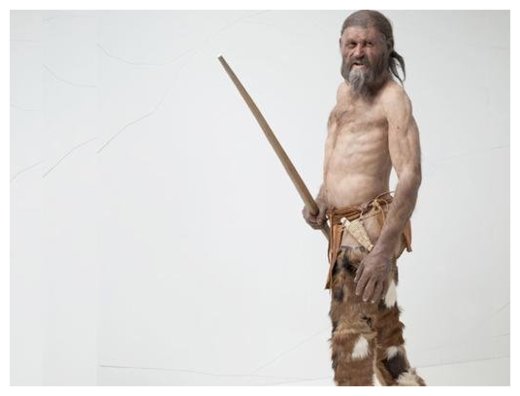
The mummy boasts tattoos grouped across 19 body parts. Earlier this year, Marco Samadelli and colleagues from the South Tyrol Museum of Archaeology, Italy, spotted a new tattoo on the mummified body, bringing the total count of the Iceman's skin markings up to 61.
Published in the February 2016 edition of the Journal of Archaeological Science: Reports, the research reveals how an error in reading radiocarbon data wrongly attributed the record to an unidentified South American mummy.
The mummy, sporting dotted mustache-like markings across the upper lip, was one of 96 bodies recovered in 1983 from El Morro, Chile. Researchers identified the naturally mummified remains as belonging to a Chinchorro male who died between 35 - 40 years of age.
They named the mummy "Mo-1 T28 C22."
The mustache-like tattoo simply consisted of eight black dots across the upper lip to the left side of the nose and four dots to the right side.
The South American mummy belonged to the Chinchorro, a preceramic fishing society that lived in the coastal regions of southern Peru and Chile between 9,000 and 3,100 years ago. Their burials feature both natural and artificial mummification, making them the oldest known human mummies.
The reported age of the mummy was around 4000 B.C., making his dotted tattoos the oldest known.
But while radiocarbon dates for Oetzi have been extensively carried out, confirming the Iceman died between 3370 and 3100 B.C., the age of the Chinchorro mummy comes from a series of errors reading the radiocarbon data.
"It is the result of confusing the date of 3830 ± 100 radiocarbon years BP," prehistoric archaeologist Aaron Deter-Wolf, who teaches the anthropology of tattooing at Middle Tennessee State University, and colleagues, wrote.
Before Present, or BP, is a time scale used in radiocarbon dating, where "Present" is AD 1950. The date reported in the 1980s radiocarbon dating was 3830 ± 100 BP, the equivalent of 1880 ± 100 BC.
But this correct date was misread as being 3830 ± 100 BC, thus generating errors that were repeated in subsequent studies.
According to the researchers, the original radiocarbon dates clearly identify Oetzi as "the oldest tattooed human remains discovered to date, predating the Chinchorro mummy Mo-1 T28 C22 by at least 500 years."
The research team, which included Benoît Robitaille, Lars Krutak, at the National Museum of Natural History, the Smithsonian Institution, and Sébastien Galliot, at the Centre de Recherche et de Documentation sur l'Océanie at Aix-Marseille Université, double checked their data by cataloging of all known tattooed human mummies.
The result was a list which included sites spanning the world and a period between around 3370 B.C. and 1600 A.D. To date, the tattoos on the Iceman's body are the oldest.
Markings were noticed on Oetzi ever since his discovery in 1991 in a melting glacier in the Oetztal Alps (hence the name). Recent non-invasive multispectral photographic imaging techniques at the South Tyrol Museum of Archaeology, investigated the tattoos.
Produced by fine incisions into which charcoal was rubbed, they consisted mainly of lines running parallel to each other, between 2 mm (0.07 inches) and 8 mm (0.3 inches) apart.
Ranging from 1 mm (0.03 inches) to 3 mm (0.1 inches) in thickness and between 7 mm (0.2 inches) and 40 mm (1.5 inches) in length, the markings concentrated in the lower section of the legs.
While the longest tattoos were detected around the wrist of the left hand, in two locations, on the knee of the right leg and on the ankle of the left foot, the lines formed a perpendicular cross.
"Although Oetzi can now be demonstrated to be the oldest tattooed human so far discovered, it is highly unlikely that he represents the first tattooed person on earth," Deter-Wolf and colleagues said.
"Oetzi's 61 marks represent physical actions performed on his body as part of established social or therapeutic practices that almost certainly existed within his culture well before his birth," they said.
The researchers anticipate that future studies will "likely provide direct evidence of tattooing predating 3200 B.C."




Reader Comments